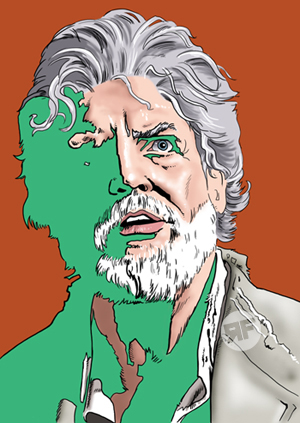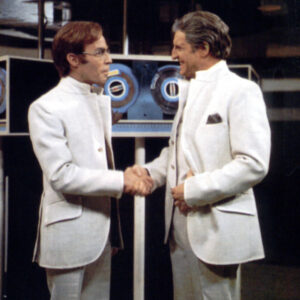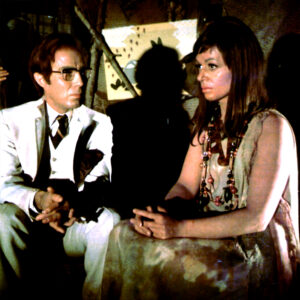
By Jimmy Stanley
After their experiences in the past visiting Second World War St Oswald in 1940 and prescient glimpses of the future in Time of the Ice Box, the two friends Liz and Simon fall through the time barrier to find themselves in an alternate projection of 1990.
When watching this story back in early 1971, I was at first intrigued with where our intrepid heroes were going to end up next. After being warned strictly not to visit the barrier by Commander Traynor, Simon’s curiosity gets the better of him, of course, and he finds himself in a very hot jungle.
The Technocrats had ruined the climate and this was the result – scorching arid jungle landscapes where no birds sang and trees withered in the extreme conditions. As a viewer, it took a while to realise that this was a very alternate projection to what Simon and Liz, who catches up with him by falling through the time barrier into this strange hot jungle, encountered on their visit to the year 1990 and the Ice Box.
The strangest part of the story as a young kid for me was when firstly Simon comes face to face with Beth – Liz’s fun-loving older self, living here in this primitive setting as an artistic sculptor. She is a complete contrast to the no-nonsense formal Ice Queen version of Beth the two had encountered in the hi-tech biological research establishment in the Antarctic in the previous 1990.
 The other cliffhanger came when Simon met his older self 2957 (David Graham) as a renegade with a conscience who had broken away, or was about to, from the Technocrats’ Master Plan of changing the climate and was now found by Simon wandering around in the jungle.
The other cliffhanger came when Simon met his older self 2957 (David Graham) as a renegade with a conscience who had broken away, or was about to, from the Technocrats’ Master Plan of changing the climate and was now found by Simon wandering around in the jungle.
It’s a scene that stayed with me for a while, that dramatic moment when he and 2957 both take off their characteristic specs to stare in disbelief as they both come face to face with their past and future selves.
Another dramatic moment is when Simon, upon hearing from 2957 about Commander Traynor’s Master Plan, eventually comes across the man himself lurking around his former office handling some reels of computer tape. Viewers would have been shocked just as I was then to see the amazing transformation the make-up department had done to make Traynor look considerably older by 20 years.
Instead of a greying middle-aged gentleman, here he was in 1990 looking somewhat shabbier, gaunt and white-haired. Quite a shock at the time and only Denis Quilley could pull off such a fabulous portrayal of the now older, slower but desperate Traynor trying to keep his autocratic Master Plan to change the world on course by doing whatever it takes to achieve that goal. His grumbling reproaches go unheeded by Simon when he tries to tell him to go back through the barrier. Simon’s curiosity gets the better of him and, as usual, leads him and Liz into hot water.
After Liz’s return to 1970 at the end of the story, there’s another particularly riveting and strange scene where she experiences the rather hallucinatory apparition of her future self while having a moment of quiet reflection in her bedroom. It’s Beth, in the future, silently and calmly appearing as a vision in her bedroom mirror. She’s almost beckoning Liz to return through the time barrier again and, of course, the girl sets off to do so much to the horror of her parents Frank and Jean.
 I found it a gripping storyline that kept me riveted, wanting to know why the future selves of all the lead characters were cast in this totally extreme setting. As time has moved on from the 1990s and into the new century, we are experiencing drastic warmer changes to our current climate.
I found it a gripping storyline that kept me riveted, wanting to know why the future selves of all the lead characters were cast in this totally extreme setting. As time has moved on from the 1990s and into the new century, we are experiencing drastic warmer changes to our current climate.
It makes me wonder how prescient the storyline was back then given what’s happening now in the world where industrialisation and powerful energy companies are the ones who, very much in line with the Technocrats of Year Of The Burn Up, decide our fate today. It’s remarkably a living testimony to an amazingly accurate children’s television series we all had the pleasure of watching…53 years ago!
When this third Timeslip story was first broadcast in 1970 – ’71, my immediate feelings were “Hey, this is heavy stuff!” To me it was fascinating but also scary and, because it was so well executed by two great leading young actors who I could relate to, it made me feel convinced that what I was witnessing here was my future too.
I can remember that each reference to the Technocrats made me afraid of the kind of future I seemed to be heading for myself. Timeslip always gave you the feeling that it was showing you a preview of the foreboding reality to come.
So, as the story progressed and we found out that this was only a projection of what might happen if we were to carry on as we were then – polluting our rivers, burning our oils, filling our atmosphere with industrial chemicals – was this the kind of world we should be expecting to live in by the 1990s, a mere 20 years away? It seemed then like a lifetime away. So it came as a relief to me when I would hear Simon reassure Liz, and indirectly us viewers, that this was only what might happen; nothing carved in stone! It did indeed paint a very frightening but intriguing picture of how the world could turn out.
 As we know now, it didn’t turn out like that in the ‘90s…thick, shady jungles in rural England. But it did serve as a friendly and very wise reminder to us younger viewers that it could do so easily if we carried on along the course the world was taking during that early ‘70s time period.
As we know now, it didn’t turn out like that in the ‘90s…thick, shady jungles in rural England. But it did serve as a friendly and very wise reminder to us younger viewers that it could do so easily if we carried on along the course the world was taking during that early ‘70s time period.
I remember hearing Neil Young’s After The Gold Rush in the same year when he sang the line “Look at Mother Nature on the run in the 1970s”; like some kind of wake-up call or early warning to the youth of the world of what’s happening to the planet.
And how appropriate that I had this same warning subconsciously embedded in my young mind by an amazing TV series that made us more aware of these forthcoming dangers.
I may have been scared, but I was hooked and still am all these years later!
